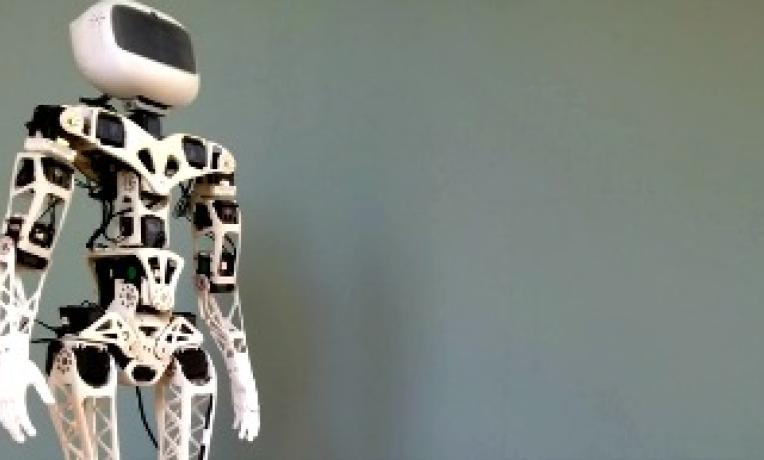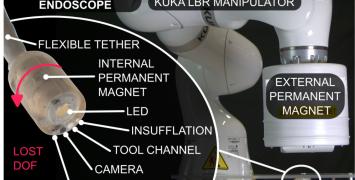Poppy, the 3-D printed robot set to inspire innovation in classrooms
It has long been a sci-fi dream to have a humanoid robot in our everyday life. Soon that dream may seem even more vivid, thanks to Dr Pierre-Yves Oudeyer’s ERC-funded project. His team has developed the first complete open-source 3D printed humanoid robot, called “Poppy”. Poppy is a robot that anybody can build – its body is 3D printed and its behaviour programmed by the user. The technology will be of benefit to the fields of science, engineering, education and even the arts.

A mirror of human learning processes
Poppy was developed by Inria's Flowers team in France, where Dr Oudeyer studies the mechanisms of learning and development using robots. “Our hypothesis is that the body is an essential variable in the acquisition of motor and social skills in humans. To study this theory, we needed to create a platform allowing fast experimentation of new robot morphologies. This led to the Poppy platform”.
Poppy's body is 3D printed and its behaviour determined with freely available software, meaning users can design body parts quickly and easily, and program their robot's behaviour themselves. Accessible hardware and software make it easy for users to experiment with building their own robots for the first time. Poppy is also compatible with platforms that allow the robot to interface with other electronic devices, such as smart clothing, lights, sensors and musical instruments.
The robot will enable scientists and engineers in various fields to experiment with different variations of the body shape and properties. For example, child development researchers could test the implications of different body geometries on the developmental process. The accessibility of 3D printing, the open source software and an associated web platform also foster collaborative scientific output, meaning any user can further develop and improve our technological understanding in open dialogue with others.
Dr Oudeyer explains, “Both hardware and software are open source. There is not one single Poppy Humanoid robot but as many as there are users. This makes it very attractive as it has grown from a purely technological tool to a real social platform”.
Poppy will indeed allow users to share their ideas and results in a very open and collaborative way through a dedicated web platform - gathering people across the frontiers of science, industry, school and art.
Do it yourself in schools
But Poppy could soon become more than a tool for scientists and computer “geeks” – the team of developers aims to use the robot as part of vocational training in schools, giving students the opportunity to experiment and program 3D printed robots with various characteristics.
Dr Pierre-Yves Oudeyer, who holds an ERC Starting Grant in Computer Science and Informatics, comments: “The advances offered by 3D printing have already revolutionised design and industry. However, only very little has been done to explore the benefits of 3D printing and its interaction with computer science in classrooms. With our Poppy platform, we are now offering schools and teachers an adequate tool to cultivate the creativity of students studying in fields such as mechanics, computer sciences, electronics and 3D printing”.
The research team has already used Poppy in other fields, including the arts. In an ongoing artist residence programme entitled “Êtres et Numériques”, the team worked with a dancer and a visual artist to explore the emotions and perceptions of body gestures and movements using the robot.
In 2012, the team collaborated with celebrated moviemaker David Lynch as part of the Ergo Robot experiment. This installation featured Poppy-based robotic creatures endowed with algorithmic models of curiosity-driven learning and language formation. David Lynch designed a head for the robots, as well as the toys they could play with, and situated them in an egg-like environment, signifying the 'origin'. The collaboration was a musing on the nature of curiosity, and an experiment in robots learning new skills and inventing their own language.
Talking about the benefits of his ERC-funded research, Dr Oudeyer highlights: “My ERC grant was essential in developing new perspectives in the design and use of robotics. It has also enabled me to compose a multidisciplinary team of highly qualified experts. Such a team has meant we have been able to collaborate with other research group, from multiple disciplines, in the world, contributing further to Poppy's development. I would now be glad if students who need more education in computer science, coding and design, could train using Poppy and perhaps, later, be able to find a job in the robotics sector”.
To find out more:
Watch Dr Oudeyer explain how open-source baby robots can help scientists, and society at large, better understand the human mysteries of learning, curiosity and language acquisition: TEDxCannes talk
- Project website
- Video
- The Ergo Robot experiment
- Poppy development team: M. Lapeyre, P. Rouanet, S. Nguyen, S. Ribas, J. Grizou, A. Le Fahler, F. Depraetre, C. Moulin-Frier, P-Y. Oudeyer.






